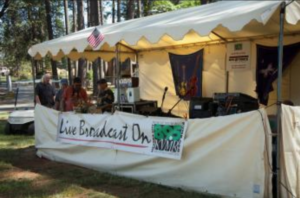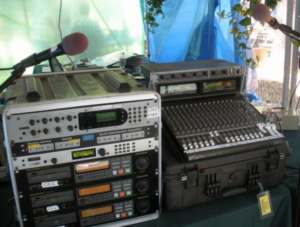Remote Input: Z/IP ONE – The Only One You Will Need
[January 2013] We have come a long way from the days when doing a remote involved days or weeks of planning with the telephone company to install a program line or an on-site search for a suitable place to set up the Marti antenna. Not only is setup easier with the latest gear, the sound quality is unsurpassed.
I remember the day we first heard audio through the Telos Z/IP ONE like it was yesterday. It changed the way we do remote broadcasts forever.
Real Community Radio
KVMR is a community radio station, licensed to Nevada City, CA.
Our primary service area is the foothills of the Sierra Nevada mountains in Northern California, but our mountain-top transmitter serves a wide area of the Central Valley as well; we also reach the Lake Tahoe area via translator. Our focus is to provide live, local programming 24 hours a day to that expanded community. Our programmers are mostly volunteers.
During the summer festival season we broadcast as many as two to three live events each month. Those live events might be anything from a single concert to a weekend-long music festival. KVMR began this tradition in 1990 when one of our programmers hooked up with a group that provided satellite backhaul services.

Since that time we have gone through many iterations of remote broadcast technology. Most recently, KVMR had used ISDN-based Telos Zephyrs for program delivery.
A Fantastic Audio Journey
While the Zephyr provides a reliable, consistent means of remote broadcast, you must have an ISDN line at the remote location.
On the other hand, as remote technology has progressed, ISDN has gotten a bit long in the tooth. In some places it is difficult, if not impossible, to have ISDN installed. Fortunately, with the advent of audio over IP, there are now more versatile and cost-effective options available.
Enter the Z/IP ONE. KVMR bought a pair of these codecs to expand our broadcast capabilities. Bottom line: our adventures with the Z/IP ONE have been nothing short of fantastic.
That First Day
Let me share a quick story with you about that first time we heard the Z/IP ONE for real. It was last summer and during a remote for a show featuring the legendary British guitarist Albert Lee, live from the Sierra Nevada Brewery in Chico, CA.
Lee’s playing style and guitar pickup configuration accentuates the “pluck” sound while he is playing. The resulting transients are sometimes difficult for a lossy codec to reproduce accurately – much more so than normal with most program material.
All Doubts Removed
At first, we were a bit nervous about how well the Z/IP ONEs would work.
To give us a secure backup, we split the signal. The Z/IP ONE was connected to a DSL line at the brewery, running at 192 kbps, while we dialed up our Zephyr Express pair via ISDN.
Back in the studio we compared the two feeds. I remember it like yesterday; the difference was amazing! So much so that I called the GM into the studio and had him listen to the A/B feed. KVMR used to carry both ISDN and IP codecs. Now, the Z/IP ONE is all they need.

Instantly, we both knew we had stumbled across something superb – and of course we ran the show live off the Z/IP ONEs, with the ISDN backup not being needed.
We did a few more events, keeping ISDN as a backup, but we only used it once, and that was because of a catastrophic outage at the wireless ISP (They lost their upstream peering).
Solid Internet Remotes
Even in rural Northern California, broadband Internet is making great inroads. Here are examples of some of the connections we have used for our live remotes:
- A fixed wireless ISP
- DSL with Ubiquiti bridge radios for the last-mile
- Standard DSL at the venue
- Cable modem
- Wi-Fi connectivity
Telos has come up with an amazingly simple, yet very effective method of connecting two Z/IP ONEs.
Piggybacking on SIP technology, the two units contact a single device, called a ZIP server. The ZIP server gathers information from each Z/IP ONE and tells them how to talk to each other. Network-wise the Z/IP ONE looks like a regular VOIP modem, and the packets negotiate standard firewalls with no additional configuration required.
Without fail, we have been able to send out our volunteer programmers into the field, have them plug the Ethernet cable into a switch at the venue, and watch while the Z/IP ONEs connect. Nothing could be easier.
Clean Audio
A good percentage of KVMR listeners are very concerned about audio quality, and the codec in the Z/IP ONE seems to satisfy even the most discriminating listener.
As mentioned before, we are running these units at 192 kbps with AAC coding. Although there is a special low-latency codec option available we have not found it to be necessary for several reasons.
First of all, most of our remotes are live broadcasts with no exchange between the studio and remote location. Additionally, the station uses HD Radio and incorporates a profanity delay, so we are already experiencing about a 15-second delay.
For these reasons we choose to set the minimum buffer length to five seconds. That setting takes care of any potential network issues and still allows us to use a very high transmission bandwidth.
With the old ISDN system there used to be a sort of “clanky-swooshy” sound (a little hard to explain, but at times objectionable) on some of the high-frequency program material and on portions of a voice with a lot of sibilance. This was especially true when listening to the broadcast in HD.
That artifact is gone with the Z/IP ONE, providing excellent fidelity to our listeners.
Goodbye ISDN
The Z/IP ONE has allowed us to improve the audio quality, reduce the cost, and expand the available locations for our live remotes.

We are trying to figure out a way to get budget and/or donation to buy another pair, and I question whether we will ever do another broadcast via ISDN.
To say that KVMR is satisfied with this product would be a big understatement. After over 20 years of live remote broadcasts I can confidently say that this little box is probably the most impresssive thing anyone around here has ever heard.
– – –
Dave Barnett is the Chief Engineer for KVMRFM in Nevada City, CA.
You can contact him at engineer@kvmr.org
– – –
Are articles like this helpful to you? If so, you are invited to sign up for the one-time-a-week.BDR Newsletter.
It takes only 30 seconds by clicking here.
– – –
